"Cab Forward" Steam Locomotives: History, Facts, Photos
Last revised: November 6, 2024
By: Adam Burns
The Cab Forward - exclusive to the Southern Pacific - represented a unique chapter in railway engineering.
The big engines and operated primarily over the challenging Sierra Nevada terrain but could also be found along the main line from Dunsmuir, California to Portland, Oregon.
They were characterized by their distinctive backward-facing appearance, a strategic design chosen to protect train crews from the hazardous smoke and noxious gases prevalent in the numerous tunnels and snow sheds of the Sierra region.
The design not only improved visibility but also significantly enhanced crew safety, showcasing a remarkable adaptation to the demanding mountainous environment.
Cab Forwards, apart from safeguarding their crews, were marvels of engineering that boasted significant power and exceptional tractive effort, adeptly handling the challenging steep gradients of the region.
Today, the legacy of these formidable engines lives on in a singular surviving example—one that captures the imagination and celebrates innovation.
Preserved with great care, Southern Pacific 4-8-8-2 #4294 stands as a proud exhibit at the California State Railroad Museum in Sacramento. This locomotive, a true gem of railway history, is thoughtfully housed indoors, continuing to inspire awe and admiration among visitors.
Photos
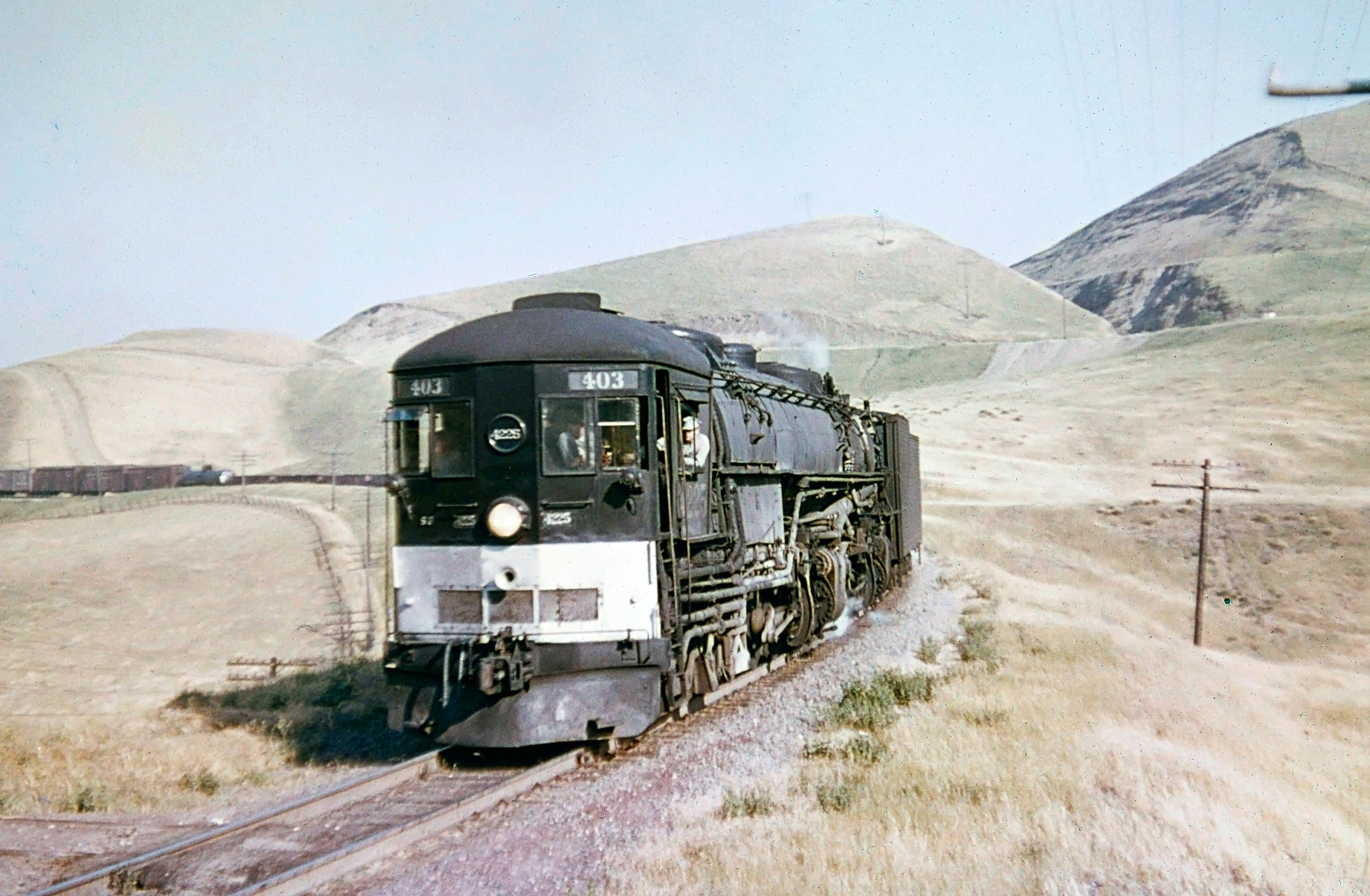 Southern Pacific 4-8-8-2 "Cab Forward" #4225 (AC-10) leads freight #403 over California's Altamont Pass during the 1950s. John Shaw photo. American-Rails.com collection.
Southern Pacific 4-8-8-2 "Cab Forward" #4225 (AC-10) leads freight #403 over California's Altamont Pass during the 1950s. John Shaw photo. American-Rails.com collection.History
One of the most distinctive and effective steam locomotive designs ever conceived was Southern Pacific's Cab Forwards. These locomotives emerged as one of the hallmark features of the 'Espee.'
Originating as a Mallet-type, the inception of the Cab Forwards dates back to 1908. It was during this time that Southern Pacific commissioned the construction of two 2-8-8-2s, designed specifically to master the arduous Sacramento Division.
This 150-mile stretch of main line traverses the Sierra Nevada, featuring daunting grades that reach up to 2.5% in certain areas. The Cab Forward was not just a marvel of engineering aesthetics, but a practical response to the unique challenges posed by this mountainous route.
Traversing the imposing high mountain passes, the main line was—and in some areas, continues to be—lined with numerous snow sheds. These structures, essential for keeping the tracks clear of snow, inadvertently presented a significant challenge for train operations.
In traditional steam locomotives, the cabs are positioned at the rear, near the tender. This design meant train crews were in the direct path of the locomotive's exhaust when passing through these enclosed snow sheds.
The accumulation of exhaust fumes in such confined spaces posed a severe hazard, leading to dangerous levels of smoke and gases that could potentially cause asphyxiation. This issue highlighted a critical need for innovation in locomotive design to ensure the safety and well-being of train crews.
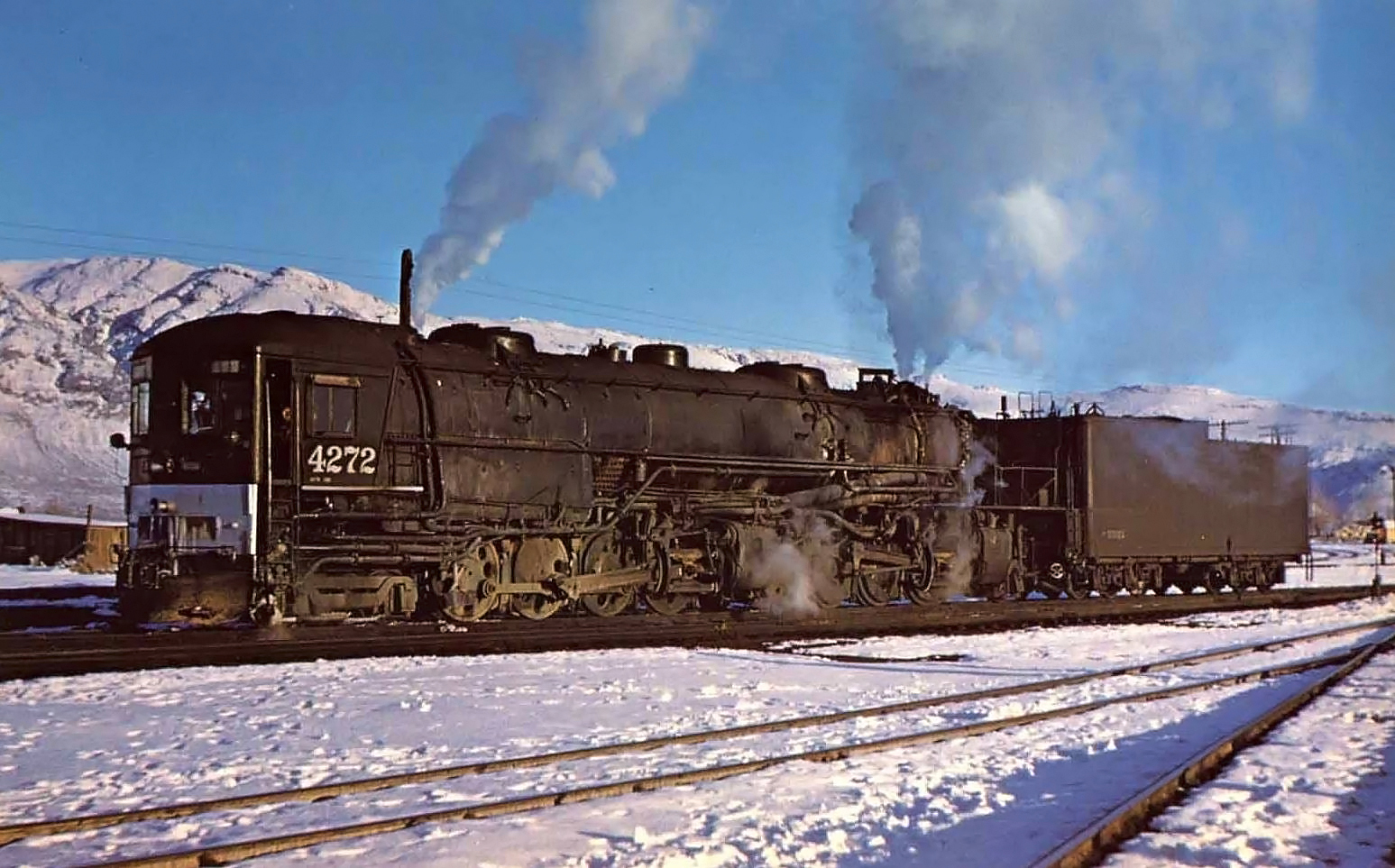 Southern Pacific 4-8-8-2 "Cab Forward" #4272 (AC-11) is ready for its next assignment at Wendel, California during January of 1956. John Hungerford photo.
Southern Pacific 4-8-8-2 "Cab Forward" #4272 (AC-11) is ready for its next assignment at Wendel, California during January of 1956. John Hungerford photo.Specifications (AC-10 thru Ac-12)
The problem of exhaust fumes affecting the men was dramatically exemplified when two Class MC-1 Mallets, #4000 and #4001, entered service on the route between Roseville and Sparks, California, just north of Sacramento.
These locomotives, though markedly more powerful than any others on SP's roster at that time, exacerbated the issue of asphyxiation. Additionally, the intense speed and velocity of the smoke exiting their stacks caused physical damage to the snow sheds by blowing off roof boards.
To mitigate the latter issue, a stack splitter was introduced, an effective modification that deflected the exhaust fumes to the sides and reduced their velocity, thus sparing the structural integrity of the snow sheds.
However, the critical issue of asphyxiation remained unresolved. Over time, frustrations among crews grew as they continued to grapple with significant breathing and visibility problems.
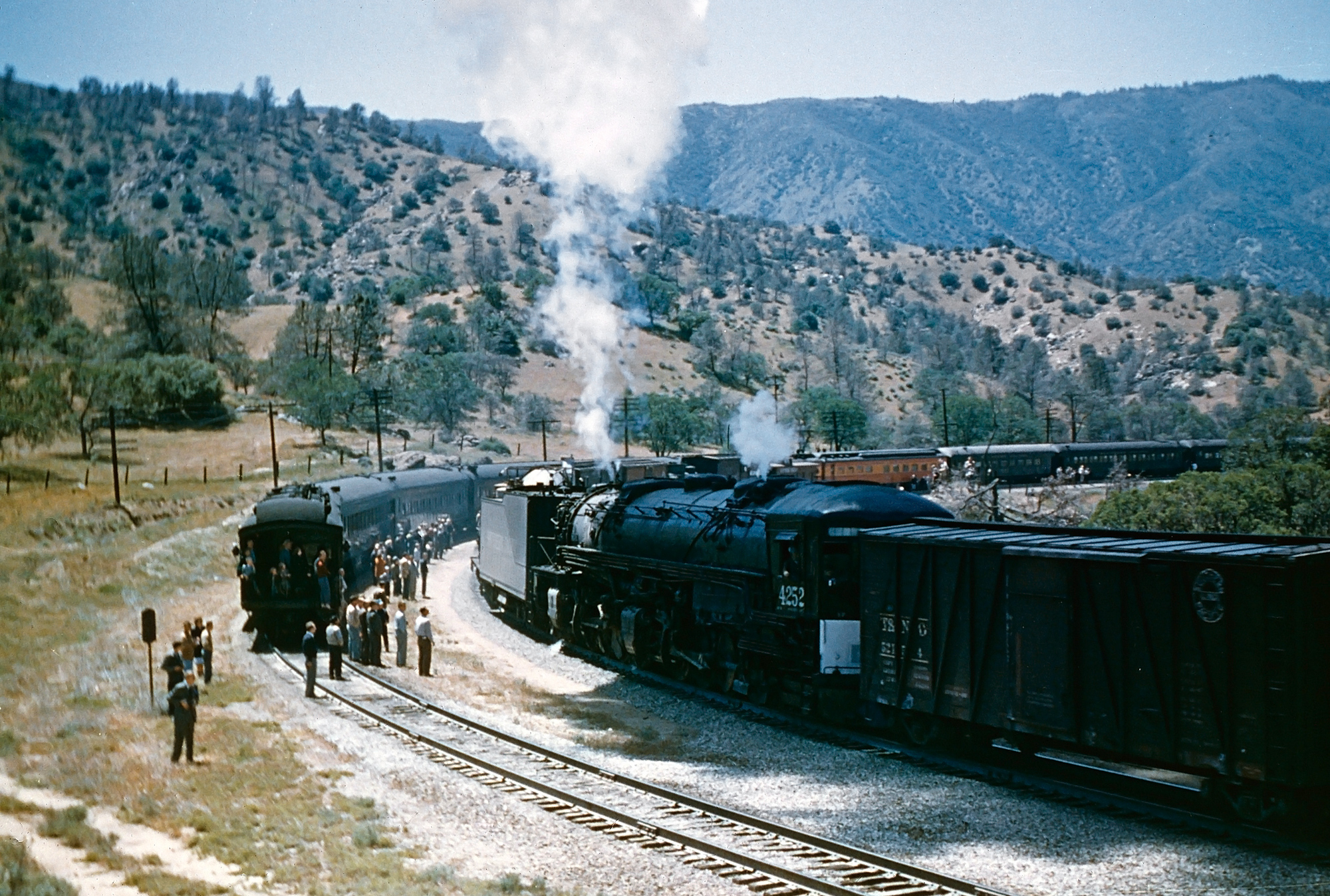 Southern Pacific 4-8-8-2 "Cab Forward" #4252 (AC-11) works helper service on Tehachapi as train enthusiasts take in the action from a railfan special during the 1950s. American-Rails.com collection.
Southern Pacific 4-8-8-2 "Cab Forward" #4252 (AC-11) works helper service on Tehachapi as train enthusiasts take in the action from a railfan special during the 1950s. American-Rails.com collection.In many respects, the evolution of the Cab Forward can be attributed directly to the ingenuity and initiative of the train crews themselves. Not long after the MC-1s began operating, one resourceful engineer decided to take matters into his own hands to ameliorate the harsh conditions faced by his team.
By ingeniously turning the locomotive around and operating it backwards, he effectively pulled the train through tunnels. This simple yet revolutionary adjustment significantly improved the working environment for the crew by mitigating the issues caused by smoke and exhaust fumes when navigating through enclosed spaces.
This practical innovation played a pivotal role in the development of the Cab Forward design. The makeshift solution of reversing the locomotive, while effective in addressing the smoke issue, introduced a new problem: it positioned the engineer on the incorrect side of the tracks, hindering his ability to clearly see the signals.
Recognizing the potential safety hazards this posed, other train crews were nonetheless compelled to adopt this method, prompting Southern Pacific to urgently seek a more sustainable solution.
In response, the railroad collaborated with the Baldwin Locomotive Works to develop the Class MC-2 2-8-8-2s, marking the introduction of the first true Cab Forwards.
These innovative locomotives, numbered 4002 through 4016, showcased a forward-facing cab that addressed visibility and safety concerns effectively. Intriguingly, these engines were pressed into service without prior testing—a bold move that underscored the urgency and confidence in this revolutionary design.
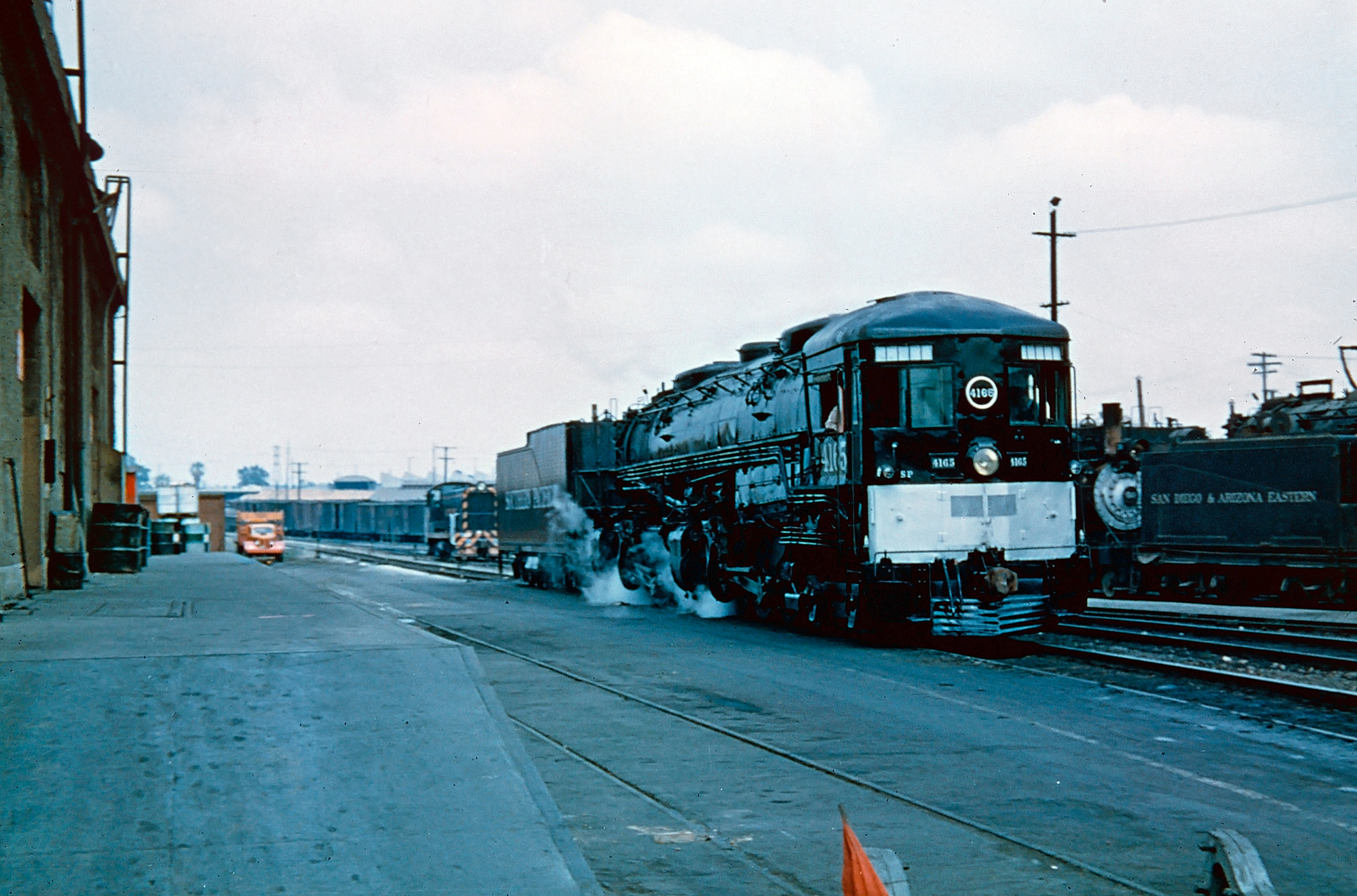 Southern Pacific 4-8-8-2 "Cab Forward" #4165 (AC-7) at Alhambra, California, circa 1949. American-Rails.com collection.
Southern Pacific 4-8-8-2 "Cab Forward" #4165 (AC-7) at Alhambra, California, circa 1949. American-Rails.com collection.The innovative Cab Forward revolutionized mountainous operations for SP. By positioning the cab at the front, the design ensured that the crew was situated well away from any smoke and exhaust, thereby radically improving the safety and comfort of the train operation.
These locomotives were successfully launched into service between February and March of 1910, utilizing oil as the primary fuel source. This choice of fuel, which could be piped from the tender directly to the firebox, was pivotal in enabling the cab to be placed at the front of the locomotive.
The introduction of the Cab Forwards proved a resounding success, adeptly addressing the challenging conditions posed by mountainous terrains.
However, despite these advancements, there remained a lingering concern among the crews about the potential dangers at grade crossings.
With the cab leading the locomotive, there was an apprehension that it would be the first point of impact in the event of a collision with a vehicle. This issue highlighted the need for continued vigilance and innovation in managing the safety aspects of railway operations.
Fortunately, the Cab Forward's innovative design proved not only effective but also remarkably safe during their four decades of operation, with no recorded incidents at grade crossings.
Initially rolled out with the 2-8-8-2 configuration, Southern Pacific later expanded its fleet to include various wheel arrangements such as 4-6-6-2s and 4-8-8-2s, the latter essentially being Yellowstones that were modified with the cab at the front.
The initial models, primarily the 2-8-8-2s and 4-6-6-2s, while revolutionary, did not boast the sheer power of their successors. The later 4-8-8-2s of the AC-4 through AC-12 classes constructed from 1930 through 1942, marked a significant upgrade in performance, offering an impressive 124,000 pounds of tractive effort compared to their predecessors' 65,000-90,000 pounds.
In total, SP would own an impressive roster of 256 Cab Forwards across different classes, each designed to conquer the challenging mountainous routes with increased efficacy and safety.
Roster
| Road Numbers | Class | Wheel Arrangement | Driver Diameter | Steam Pressure | Tractive Effort (Pounds) | Horespower | Builder | Date Built |
|---|---|---|---|---|---|---|---|---|
| 3800-3811 | AC-9 (Standard Cab) | 2-8-8-4 | 63 | 250 | 124,300 | 6,000 | Lima | 1939 |
| 3900-3911 | AM-2 | 4-6-6-2 | 63 | 210 | 76,800 | 3,450 | Southern Pacific | 1920 |
| 4000-4001 | MC-1 | 2-8-8-2 | 57 | 200 | 85,040 | 4,000 | Baldwin | 1908 |
| 4002-4016 | MC-2 | 2-8-8-2 | 57 | 200 | 85,040 | 4,000 | Baldwin | 1910 |
| 4000-4016 | AC-1 | 2-8-8-2 | 57 | 210 | 90,940 | 4,350 | Southern Pacific | 1931 (Rebuilt from MC-1's and MC-2's.) |
| 4017-4028 | MC-4 | 2-8-8-2 | 57 | 200 | 85,040 | 4,000 | Baldwin | 1911 |
| 4017-4028 | AC-2 | 2-8-8-2 | 57 | 210 | 90,940 | 4,350 | Southern Pacific | (Rebuilt from MC-4's.) |
| 4029-4048 | MC-6 | 2-8-8-2 | 57 | 200 | 85,040 | 4,000 | Baldwin | 1912-1913 |
| 4029-4048 | AC-3 | 2-8-8-2 | 57 | 200 | 90,940 | 4,350 | Southern Pacific | (Rebuilt from MC-6's in the late 1920's.) |
| 4100-4109 | AC-4 | 4-8-8-2 | 63 | 235 | 116,900 | 5,640 | Baldwin | 1928 |
| 4110-4125 | AC-5 | 4-8-8-2 | 63 | 235 | 116,900 | 5,640 | Baldwin | 1928 |
| 4126-4150 | AC-6 | 4-8-8-2 | 63 | 250 | 124,300 | 6,000 | Baldwin | 1930 |
| 4151-4176 | AC-7 | 4-8-8-2 | 63 | 250 | 124,300 | 6,000 | Baldwin | 1937 |
| 4177-4204 | AC-8 | 4-8-8-2 | 63 | 250 | 124,300 | 6,000 | Baldwin | 1937 |
| 4205-4244 | AC-10 | 4-8-8-2 | 63 | 250 | 124,300 | 6,000 | Baldwin | 1942 |
| 4200-4211 | MM-2 | 4-6-6-2 | 63 | 200 | 65,900 | 3,000 | Baldwin | 1911 |
| 4245-4274 | AC-11 | 4-8-8-2 | 63 | 250 | 124,300 | 6,000 | Baldwin | 1942 |
| 4275-4294 | AC-12 | 4-8-8-2 | 63 | 250 | 124,300 | 6,000 | Baldwin | 1942 |
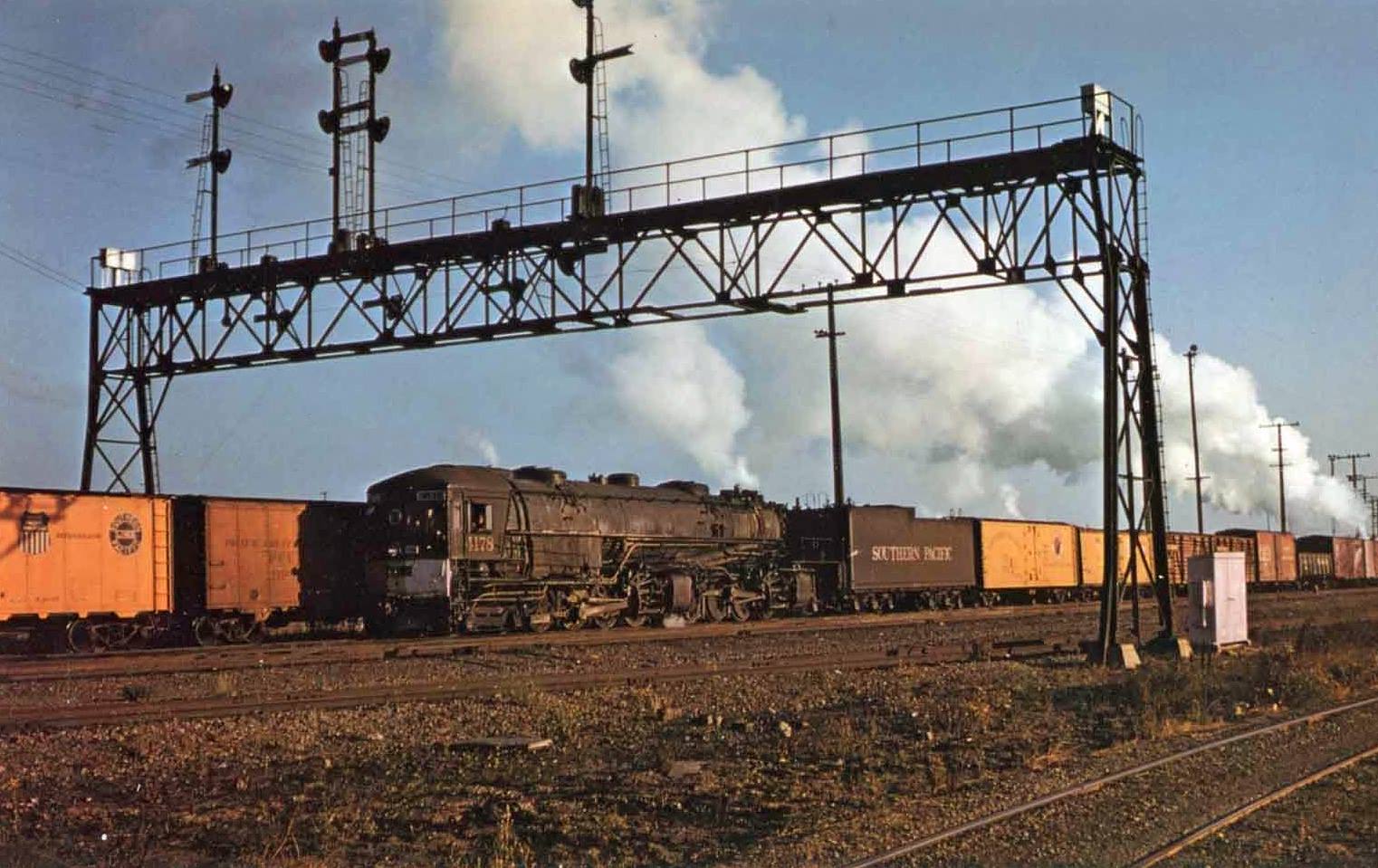 A Southern Pacific 4-8-8-2 "Cab Forward" (AC-8) leads extra #4178 past Oakland's 16th Street Station on September 23, 1955. Harold Stewart photo.
A Southern Pacific 4-8-8-2 "Cab Forward" (AC-8) leads extra #4178 past Oakland's 16th Street Station on September 23, 1955. Harold Stewart photo.Preservation
Though the final models of the AC-10/12 classes were in service for just over a decade, these locomotives demonstrated remarkable reliability and proficiency, adeptly managing the formidable task of hauling heavy loads across the Sierra Nevada mountain range.
Regrettably, the era of these steam giants drew to a close as diesels began to take precedence, culminating on November 30, 1956, when Class AC-10 #4211 made its final journey from Oakland to Davis, marking the end of an impressive chapter in railway history.
In a fortunate turn of events for history enthusiasts and engineering aficionados, one of these extraordinarily unique locomotives has been meticulously preserved.
4294, distinguished as the very last Cab Forward ever constructed, was honored in May, 1981 as a National Historical Mechanical Engineering Landmark.
Today, it proudly resides at the California State Railroad Museum in Sacramento, serving as a testament to a remarkable period of locomotive innovation and a bridge to the rich historical heritage of American railroading.
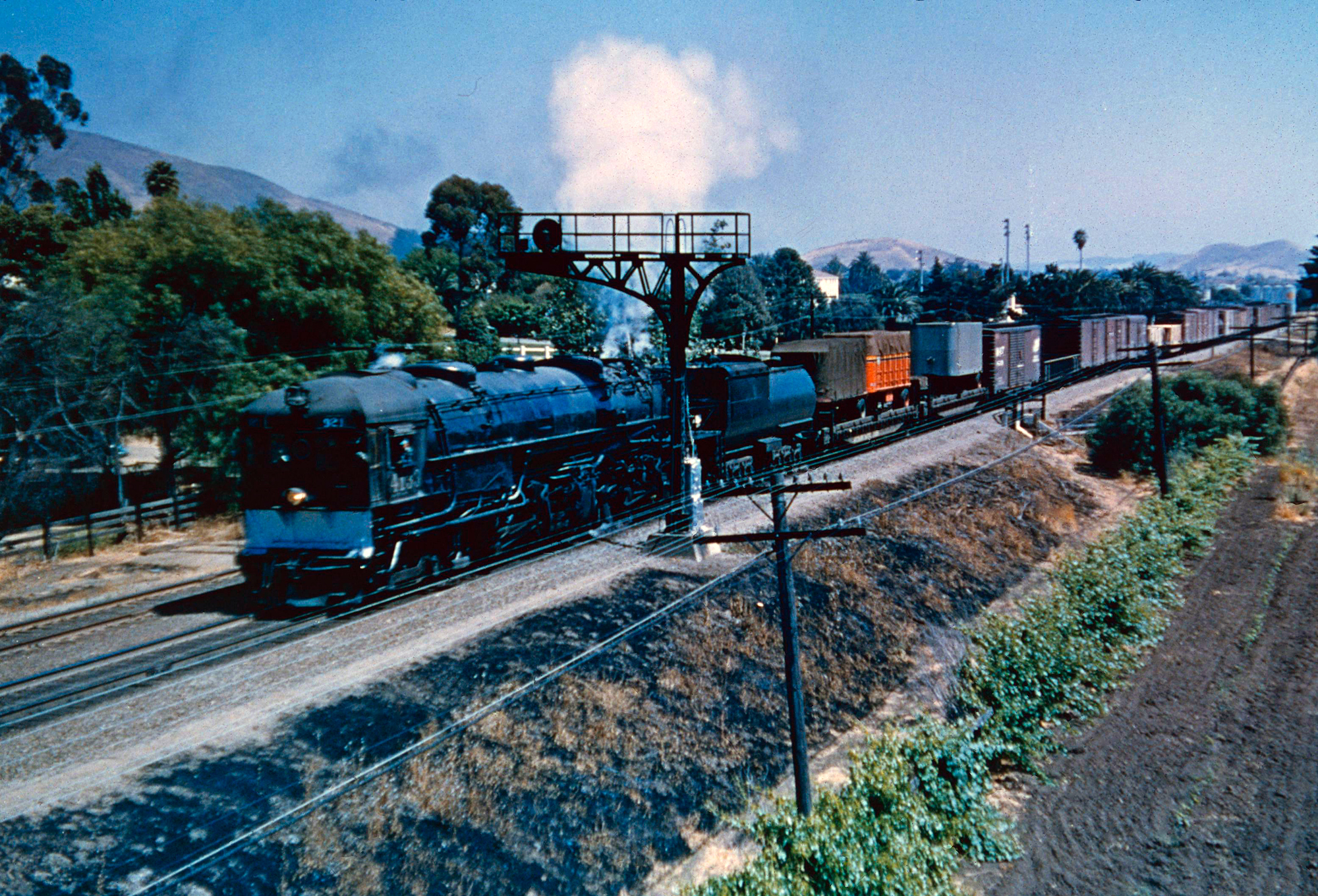 Southern Pacific 4-8-8-2 "Cab Forward" #4133 (AC-6) steams through San Luis Obispo, California with a long general manifest freight in July, 1955. John Shaw photo. American-Rails.com collection.
Southern Pacific 4-8-8-2 "Cab Forward" #4133 (AC-6) steams through San Luis Obispo, California with a long general manifest freight in July, 1955. John Shaw photo. American-Rails.com collection.Sources
- Solomon, Brian. Baldwin Locomotives. Minneapolis: Voyageur Press, 2009.
- Solomon, Brian. Majesty Of Big Steam, The. Minneapolis: Quarto Publishing Group, 2015.
- Solomon, Brian. Southern Pacific Railroad. St. Paul: Voyageur Press, 2007.
- Yenne, Bill. History Of The Southern Pacific, The. New York: Bonanza Books, 1988.
Recent Articles
-
Texas - Wine Tasting - Train Rides
Dec 21, 25 11:05 AM
This article invites you on a metaphorical journey through some of these unique wine tasting train experiences in Texas. -
New York - Wine Tasting - Train Rides
Dec 21, 25 10:58 AM
This article will delve into the history, offerings, and appeal of wine tasting trains in New York, guiding you through a unique experience that combines the romance of the rails with the sophisticati… -
Pennsylvania - Whiskey - Train Rides
Dec 20, 25 09:06 PM
For whiskey aficionados and history buffs alike, a train ride through the Keystone State offering such spirits provides a unique and memorable experience.



